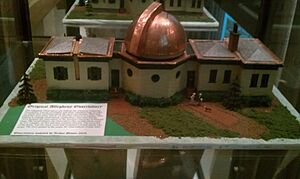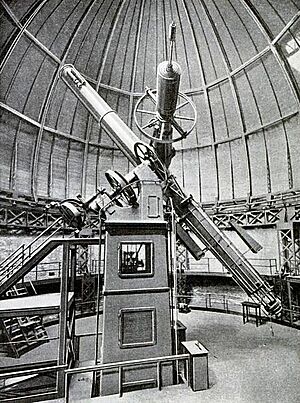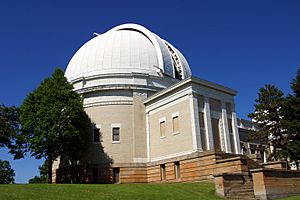Allegheny Observatory facts for kids
Quick facts for kids Allegheny Observatory |
|||||||||||||||||||||||||||||||||||||
|---|---|---|---|---|---|---|---|---|---|---|---|---|---|---|---|---|---|---|---|---|---|---|---|---|---|---|---|---|---|---|---|---|---|---|---|---|---|

The observatory in 2013
|
|||||||||||||||||||||||||||||||||||||
| Organization | University of Pittsburgh | ||||||||||||||||||||||||||||||||||||
| Location | Pittsburgh, Pennsylvania | ||||||||||||||||||||||||||||||||||||
|
Coordinates
|
40°28′57″N 80°01′15″W / 40.482525°N 80.020829°W
|
||||||||||||||||||||||||||||||||||||
| Established | February 15, 1859 | ||||||||||||||||||||||||||||||||||||
| Website Allegheny Observatory |
|||||||||||||||||||||||||||||||||||||
|
|||||||||||||||||||||||||||||||||||||
The Allegheny Observatory is a special place where scientists study the stars and space. It is part of the University of Pittsburgh's Department of Physics and Astronomy. This observatory is very important! It is listed on the National Register of Historic Places and is a historic landmark for both Pennsylvania and Pittsburgh.
Contents
History of the Observatory
The Allegheny Observatory started on February 15, 1859. It was founded by a group of rich business people called the Allegheny Telescope Association. They wanted the observatory to teach the public about space, not just for research.
By 1867, not many people were visiting, so the observatory was given to the Western University of Pennsylvania. This university is now known as the University of Pittsburgh.
Samuel Langley's Time Service
The University hired Samuel Pierpont Langley to be the first director. He started a research program to study sunspots. His detailed drawings of sunspots are still used in astronomy books today. He also made the building bigger, adding dark rooms, classrooms, and a lecture hall.
In 1869, Langley found a way for the observatory to make money. He sold a service that provided very accurate time. This time was figured out by looking at the stars. It was then sent to customers using telegraphs.
The Pennsylvania Railroad was a big customer of this "Allegheny Time" system. This service is thought to be the first regular system to give accurate time to railroads and cities. It also led to our modern standard time system. By 1870, Allegheny Time signals reached over 2,500 miles and 300 telegraph offices.
On November 18, 1883, standard time for railroads began in North America. The Allegheny Observatory sent a signal by telegraph. This signal marked noon, Eastern Standard Time. Railroads across the continent set their schedules based on this signal. The standard time that started that day is still used in North America today.
The money from selling time signals paid for Langley's salary and the observatory's bills. The Allegheny Observatory kept providing time signals until the US Naval Observatory started offering it for free in 1920.
Searching for Planets
More recently, George Gatewood started using the Allegheny Observatory to look for planets outside our solar system, called extrasolar planets. He began this work in 1972. He used a method called astrometry. Astrometry is the science of measuring the exact positions of stars.
George Gatewood studied thousands of old photographs of stars. He also designed a special tool called the Multichannel Astrometric Photometer (MAP). This tool helped measure the position of a star and its nearby stars. It looked at images taken six months apart. This method uses something called parallax.
If a star has an unseen planet orbiting it, the star will "wobble" a tiny bit. This wobble is caused by the planet's gravity. By measuring the size of the wobble, scientists can figure out the size of the planet.
The MAP tool is no longer used. The Thaw telescope is currently being updated with new wiring.
A small model of the original observatory can be seen at the Miniature Railroad & Village exhibit in the Carnegie Science Center in Pittsburgh. In 2012, a movie was made about the observatory's history.
The Mystery of the Missing Lens
This is a strange story from when Samuel Langley was the director. On July 8, 1872, Langley came back to Allegheny City after a meeting. His staff told him that the lens of the 13-inch Fitz Telescope had been stolen! The thief wanted money for its return, but Langley refused to pay.
No one knows for sure who the "lens-napper" was. Some people think Langley knew! The thief worried that newspapers investigating the theft might discover their identity. So, the thief told Langley he could have the lens back.
The thief did not say where it was, but it was later found in a trash can at a hotel in Beaver Falls, Pennsylvania. Sadly, the lens was scratched and could not be used. It had to be re-ground by a famous lens maker named Alvan Clark.
When the lens was put back, it worked even better than before! So, the lens-napping actually helped the observatory. To show his thanks, Langley added Clark's name to the telescope.
Early Flight Research
Samuel Langley also did research on things that could fly, right behind the observatory. He wanted to study how different shapes moved through the air at high speeds. He built a large "whirling arm" with a spring. He attached stuffed birds and wings he made to this arm.
After leaving the Allegheny Observatory in 1888, Langley became the secretary of the Smithsonian. He continued his flight research there. He designed and flew the first unmanned aircraft that could fly steadily on its own power. He launched it from a houseboat on the Potomac River.
Later, the U.S. Army paid for his full-size manned aircraft, called the Langley Aerodrome. But in 1903, the Aerodrome crashed twice, and Langley stopped his flight research.
The New Allegheny Observatory
The original observatory building was replaced by the one you see in pictures today. It was designed in a beautiful Classic Revival style by Thorsten E. Billquist. The first stone was laid in 1900, and the new building was finished in 1912.
It is located about four miles north of downtown Pittsburgh, Pennsylvania, in Riverview Park. The building is made of tan brick and white terra cotta. It looks like a classical temple on a hilltop. Its design shows how art and science can work together.
The building is shaped like an "L." It has a library, a lecture hall, classrooms, labs, offices, and three round domes for telescopes. Two domes were for research, and one was for schools and the public to use.
In the middle of the building is a small round room called a rotunda. It has a beautiful glass window showing Urania, the Greek muse of astronomy. This window was designed by artist Mary Elizabeth Tillinghast.
In the basement of the observatory, there is a special crypt. This crypt holds the ashes of two important astronomers and former directors of the Allegheny Observatory: James Edward Keeler and John Brashear. It also holds the remains of Brashear's wife, Phoebe, and Keeler's wife, Cora Matthews Keeler, and their son, Henry Bowman Keeler.
The original observatory building was used by the university's football team as a training center in 1907. It was later sold and torn down in the 1950s. Today, a school called Triangle Tech is on that site.
What's Happening Now

Today, the main research at the Allegheny Observatory is finding extrasolar planets. This is done using photometry. Photometry is the practice of measuring how bright stars are.
Scientists take digital images every 30 to 60 seconds. They measure the brightness of a star and its nearby stars. If a planet passes in front of its parent star, the star's brightness drops a little. The amount the star dims tells scientists about the sizes of the star and the planet.
Students at the University of Pittsburgh are part of this research team. Their observations have helped in a project to watch a planet called HD 80606 b cross in front of its star. The group is also working to upgrade the Allegheny Observatory.
In 2009, the university's Department of Geology and Planetary Science added a seismic station to the observatory. This station is the only one in Western Pennsylvania that is connected to the IRIS Consortium networks. It helps study earthquakes.
Public Tours
When the new Allegheny Observatory was designed, it was made with the public in mind. The building plan included a lecture hall. When the new observatory first opened, it was open to the public on every clear evening. People could look through the 13-inch telescope. If it was cloudy, they would get a lecture about astronomy.
John Brashear once said that "the Allegheny observatory would remain forever free to the people." And it has! Even today, free public tours are offered a couple of nights each week.
See also
 In Spanish: Observatorio de Allegheny para niños
In Spanish: Observatorio de Allegheny para niños





